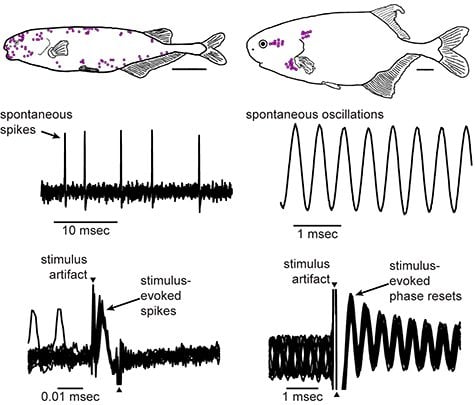The more than 200 species in the family Mormyridae communicate with one another in a way completely alien to our species: by means of electric discharges generated by an organ in their tails.
In a 2011 article in Science that described a group of mormyrids able to perceive subtle variations in the waveform of electric signals, Washington University in St. Louis biologist Bruce Carlson, PhD, noted that another group of mormyrids are much less discriminating.
The fish with nuanced signal discrimination can glean a stunning amount of information from electric signals, including the signaler’s species, sex, age, relative dominance status, and possibly even individual identity. They can also detect emotional states, such as aggression, submission, courtship and active exploration.
The fish with the simpler communication system were less studied and less well understood.
In the August 4 issues of the online journal eLife, Carlson and graduate student Christa Baker describe how they discovered the basis for the perceptual differences between the two groups of fish by studying the fish’s sensory receptors.
“There had to be a neural correlate for the perceptual differences, so we looked to see if something was happening ‘out in the periphery’ where the signals are originally detected and encoded for processing in the brain,” Carlson said.

The receptors in the less discriminating fish encode signals very differently than do the receptors in the more discriminating fish. Further, the receptors of the less discriminating fish are tuned to the collective signals from schools or shoals of fish rather than to those from individual fish.
“As far as we know, this is the first time anyone has found a receptor tuned to group communication signals rather than those coming from individuals,” Carlson said.
Spiking versus oscillating
Weakly electric fish have sensory receptors in their skin, called knollenorgans, that detect electric pulses from their neighboring fish. The receptors are broadly distributed over the bodies of the discriminating fish, but in the less discriminating fish they are grouped into three clusters, or rosettes, on both sides of the head.
“We knew from work in the 1960s that there were differences in the physiology, or electrical behavior, of the sensory receptors,” Baker said. “The broadly distributed receptors fire spikes, or action potentials, whereas the clustered receptors produce oscillating potentials at a constant frequency.”
“We learned that when the oscillating recepters receive an electric signal, they reset their oscillation to a particular point in the cycle,“ she said. “This phase reset briefly syncrhonizes the oscillations of different receptors.”
“No one had ever described anything like this in a sensory system before,” Carlson said. “This is the first sensory receptor we know of that encodes stimuli by resetting the phase of ongoing oscillations.”
“We investigated how the phase reset varied with different stimuli,” Baker said, “and we found that the oscillating receptors do not encode the same information as spiking receptors.”

The spiking receptors, which fire a nerve impulse every time there is an upward or downward excursion in the signal, are very good at encoding precise timing cues in signaling waveforms. But oscillating receptors encode only the onset of the signal and its point of origin.
“Fish with oscillating receptors are not behaviorally sensitive to waveform variation at least in part because the precise timing cues are not encoded by their receptors,” Baker said.
Group think
So why do the fish with oscillating receptors bother to signal at all? What information do their receptors provide? The answer emerged when the scientists looked at how the receptors are tuned.
The spiking receptors are maximally sensitive to frequencies near those that make up the signals from other members of their species. The oscillating receptors, however, are tuned to much lower frequencies than those that characterize signals from their fellow fish.
“We found that the timing patterns they were most sensitive to were patterns that can only be produced by the collective signaling of large groups of fish,” Baker said. “We think that the oscillating receptors help fish detect and locate those groups.”
But why are these two groups of fish so different? “Our best guess is that differences in social behavior, in social organization, selected for differences in sensory capacities,” Carlson said.
“Based on what I’ve seen in the field,” he said, “the fish able to perceive small differences in the communication signals tend to be solitary and territorial, whereas the fish whose receptors are tuned to group signals tend to be more gregarious.
Electric Evolution
“My guess is that these two different lifestyles place very different selective pressures on communication. If you’re solitary and territorial and you detect another fish in the area, you want to know exactly who that fish is. Is it a potential competitor, a potential mate, or a different species you’re not worried about?
“On the other hand, if you’re living in a shoal or school of fish, it’s not so important to identify individuals. Just sticking with the group is going to be a successful strategy.”
Source: Diana Lutz – Washington University in St. Louis
Image Credit: The images are created to Bruce Carlson/ Carlson and Baker
Video Source: The video is available at the Washington University in St. Louis YouTube page
Original Research: Full open access research for “Peripheral sensory coding through oscillatory synchrony in weakly electric fish” by Christa A Baker, Kevin R Huck, and Bruce A Carlson in eLife. Published online August 4 2015 doi:10.7554/eLife.08163
Abstract
Peripheral sensory coding through oscillatory synchrony in weakly electric fish
Adaptations to an organism’s environment often involve sensory system modifications. In this study, we address how evolutionary divergence in sensory perception relates to the physiological coding of stimuli. Mormyrid fishes that can detect subtle variations in electric communication signals encode signal waveform into spike-timing differences between sensory receptors. In contrast, the receptors of species insensitive to waveform variation produce spontaneously oscillating potentials. We found that oscillating receptors respond to electric pulses by resetting their phase, resulting in transient synchrony among receptors that encodes signal timing and location, but not waveform. These receptors were most sensitive to frequencies found only in the collective signals of groups of conspecifics, and this was correlated with increased behavioral responses to these frequencies. Thus, different perceptual capabilities correspond to different receptor physiologies. We hypothesize that these divergent mechanisms represent adaptations for different social environments. Our findings provide the first evidence for sensory coding through oscillatory synchrony.
“Peripheral sensory coding through oscillatory synchrony in weakly electric fish” by Christa A Baker, Kevin R Huck, and Bruce A Carlson in eLife. Published online August 4 2015 doi:10.7554/eLife.08163






